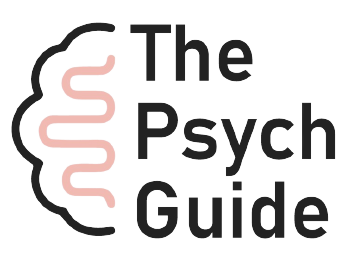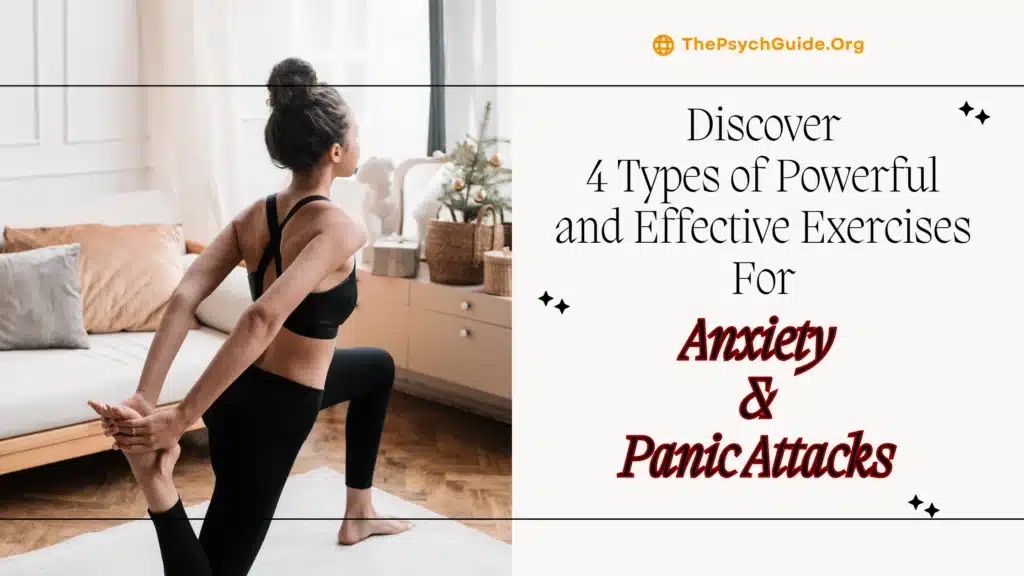Are you tired of feeling overwhelmed by anxiety and panic attacks? Do you long for a sense of calm and control in your everyday life? Well, you’re not alone. There’s good news: exercise can be a powerful tool to help you manage these feelings and find relief. There are exercises for anxiety and panic attacks that can be helpful to overcome them.
Anxiety and panic attacks affect millions of people worldwide. These common mental health challenges can leave us feeling helpless and out of control. But imagine being able to calm your pounding heart, quiet your racing thoughts, and regain control when anxiety and panic attacks strike.
In this blog post, we’ll explore a variety of exercises specifically designed to help with anxiety and panic attacks. So, grab a cup of tea, get comfortable, and let’s dive into the world of easy and effective exercises for anxiety and panic attacks.
Table of Contents
ToggleWhat is Anxiety and Panic Attacks?
Anxiety is a feeling of worry, nervousness, or unease about a future event and uncertain outcomes. It is often triggered by stressful events. It becomes a disorder when it interferes with your daily life.
Its symptoms include:
- Excessive worrying
- Racing thoughts
- Difficulty concentrating
- Muscle tension
- Restlessness
- Fatigue
- Irritability
- Sleep problems
Panic Attacks
Panic attacks are sudden episodes of intense fear that arise unexpectedly without a clear trigger. They are not related to any external threat or event and are severe, with overwhelming symptoms that can peak within minutes.
Its symptoms include:
- Racing heartbeat
- Dizziness
- Muscle tension
- Trembling or shaking
- Sweating
- Shortness of breath or feeling of choking
- Chest pain or discomfort
- stomach discomfort or nausea
- Dizziness or lightheadedness
- The feeling of detachment or unreality
- Fear of losing control or dying
Difference between Anxiety and Panic Attacks
| Anxiety | Panic Attacks |
| Anxiety is not that severe as compared to panic attacks. | Panic attacks are much more intense than anxiety attacks. |
| Anxiety often builds gradually. | Panic attacks occur suddenly. |
| Anxiety often has a clear trigger. | Panic attacks can arise out of the blue. |
| Anxiety can persist for longer periods. | Panic attacks typically last for minutes. |
Does Exercise Help Panic Attacks and Anxiety?
Are you unsure if exercising can actually assist you in overcoming panic attacks and anxiety? So the answer is yes; it surely can. Exercise is a powerful ally when it comes to managing anxiety and stress. It’s not just a boost for your physical health; it’s a game-changer for your mental well-being too. Studies from PMC back this up, showing how regular physical activity can seriously benefit your mental health. Think of it as a vital tool in your stress-management toolkit.
How Exercise Affects Mental Health
Let’s look at how exercise affects your mental health and well-being.
- When you get moving, it triggers the release of endorphins that reduce stress and increase feelings of happiness and well-being.
- Exercise helps lower cortisol levels, the primary stress hormone. Lower cortisol means a calmer nervous system and a better ability to cope with stressful situations.
- Regular physical activity promotes better sleep quality, which is crucial for maintaining good mental health.
- Elevating your heart rate alters the chemistry of your brain, making key neurochemicals that reduce anxiety more accessible. These neurochemicals include endocannabinoids, brain-derived neurotrophic factor (BDNF), gamma-aminobutyric acid (GABA), and serotonin.
- Exercise stimulates the frontal brain regions involved in executive function, which aids in regulating the amygdala, our survival response system to perceived or actual threats. This helps your brain’s “worry center” to calm down when it’s freaking out about things that might not even happen.
Benefits of Regular Exercise
There are many benefits and positive effects of exercise and physical activity on anxiety and panic attacks. Doing a workout daily can positively affect your mental health.
- Regular exercises reduce anxiety symptoms, as studies have shown that doing exercises regularly can be as effective as therapy in reducing anxiety symptoms. You can have less worry, nervousness, and racing thoughts.
- Regular exercises can enhance your stress resilience by equipping your mind and body to better handle stressful situations.
- The mood-boosting effects of exercise can help combat feelings of depression and negativity. You’ll likely experience a more optimistic outlook on life.
- Exercise increases your energy levels by combating fatigue, leaving you feeling more motivated and able to tackle your day.
- Exercise provides a healthy distraction from worries and negative thoughts. Focusing on exercises and physical activities can give your mind a break from other unhealthy distractions.
- Achieving fitness goals and pushing your limits can boost your self-confidence and self-esteem. It can make you feel good about yourself overall, improving your mental health.
- Engaging in exercise and physical activities provides opportunities to connect with others. Even a simple smile or a friendly greeting while strolling in your neighborhood can contribute to lifting your mood.
A tip to remember: Start slowly and gradually increase the intensity and duration of your exercises. It’s about progress, not perfection!
Types of exercises for anxiety and panic attacks
Numerous exercises can help lessen the symptoms of anxiety and panic attacks. The relationship between exercise and anxiety goes hand in hand, as research shows that people who exercise regularly have a better frame of mind. Let’s discuss them so you can easily practice these exercises in your daily routine.
Aerobic Exercises
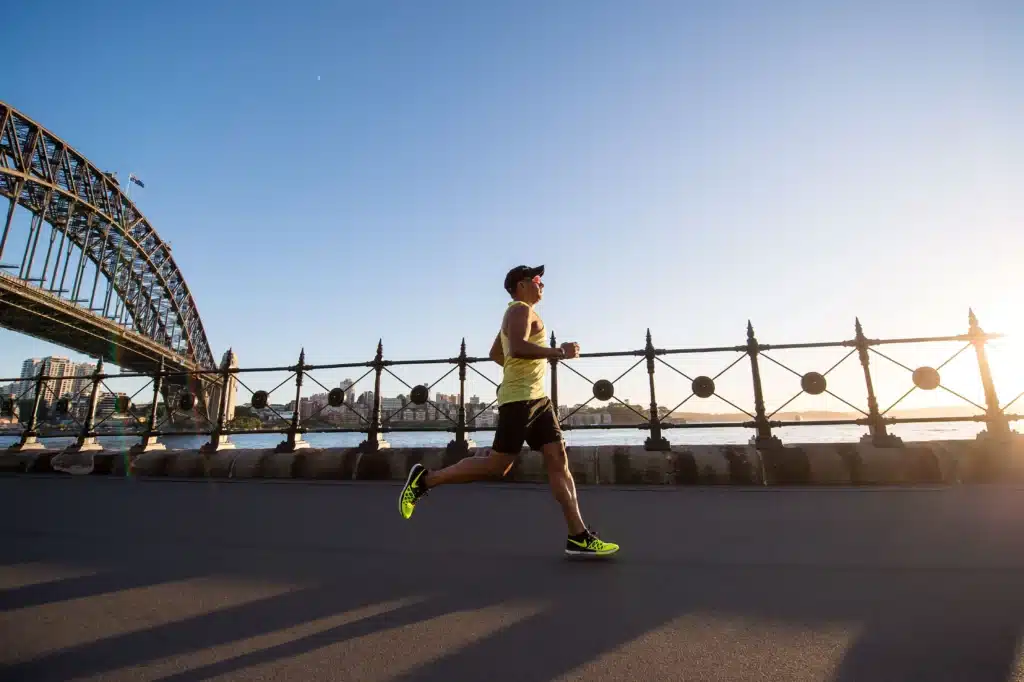
According to 2018 research, regular aerobic exercise helps reduce anxiety and panic attacks. Aerobic exercises can also help as an add-on in therapy, as the research study indicates that aerobic exercise training enhances the efficacy of cognitive behavioral therapy in panic disorder.
Running, jogging, cycling, swimming, and dancing are all excellent aerobic exercises that can help manage anxiety and lessen the frequency and severity of panic attacks.
1. Running
Running can help you clear your mind while reducing stress. A clear mind and reduced stress can help reduce anxiety, panic attacks, and depression symptoms.
How does it help?
- Running improves your cognitive functions, such as attention and focus, which are helpful in managing your thoughts when you are going through a panic attack.
- Running provides a sense of control over your body and movement, acting as a potent remedy for anxiety and panic. The repetitive motion of running can help to ground you in the present moment and distract you from anxious thoughts.
- The focused, rhythmic breathing while running regulates your breath and calms the nervous system, a known technique for managing anxiety.
- Regular running improves sleep quality by regulating the sleep-wake cycle and boosting melatonin production, promoting better sleep.
How much to do?
Don’t try to run too much initially. Start slowly and with short distances and sessions of 10-15 minutes, then gradually increase the duration. Run at a pace that allows you to breathe comfortably and enjoy it. Also, try to be consistent. Make time for it every day.
2. Cycling
Is cycling your favorite spare time thing? Then you are good to go. Let me tell you how it helps in terms of panic and anxiety.
- Cycling releases feel-good hormones known as endorphins and these hormones make you feel happier and relax your mind.
- A study showed that aerobic exercises such as running and cycling can reduce feelings of anxiety, potentially preventing anxiety from developing into full-blown panic attacks.
So if you want to get rid of anxiety and panic attacks, start cycling today. It’s easier as compared to going to the gym and paying hefty amounts.
How much to do?
Initially, aim for short cycling sessions of 15-20 minutes, three times a week, and during cycling, maintain a comfortable pace. Focus on enjoying it and don’t push yourself too hard. Cycling with relaxation techniques such as deep breathing exercises can be helpful for anxiety and panic attacks.
3. Swimming
Do you love swimming? Well, apart from indulging in your passion, swimming also offers significant benefits for managing anxiety and panic attacks. Let’s delve into its benefits.
How does it help?
- Research indicates that consistent swimming can alleviate anxiety by releasing endorphins, serotonin, and dopamine, which promote a sense of relaxation and resilience to stress.
- Water in its own nature can also make you feel calm and at peace, freeing your mind from worries.
- Swimming demands control of your breath so it is the best exercise for anxiety and panic attacks as it calms your nervous system. Regular swimming makes breathing exercises easier.
- Swimming in warm water can decrease depression and improve your mood, while swimming in cold water can also elevate your mood, according to the research.
How much to do?
Start swimming for 10-15 minutes and as your stamina and comfort level improve, then increase the duration of your swimming sessions. Try to swim regularly, even for a shorter period of time.
4. Dancing
There are many positive effects of exercise and physical activity on anxiety and panic attacks and dancing is also on the list. Dancing is a form of exercise and physical activity so it reduces anxiety and elevates your mood by releasing feel-good hormones.
How does it help?
- When you dance, your focus and attention are on the rhythm, music, and your body movements, so it diverts your mind from anxious thoughts and worries and shifts your focus to the present moment.
- Dancing requires coordination, balance, and awareness of your body. This heightened focus on your body’s movements can promote a positive mind-body connection, giving you a more grounded and centered state of being that helps when sudden panic attacks overcome and you become anxious.
So how about adding dancing to your life and gaining its benefits in terms of anxiety and panic attacks?
How much to do?
In the beginning, try dancing for a few minutes each day, and then gradually increase the duration. Look at how your body feels during and after dancing and if you experience increased anxiety and panic, then take a break. Also combine your dancing with other techniques such as mindfulness, deep breathing, and meditation to have greater effects on anxiety and panic attacks
Strength Training
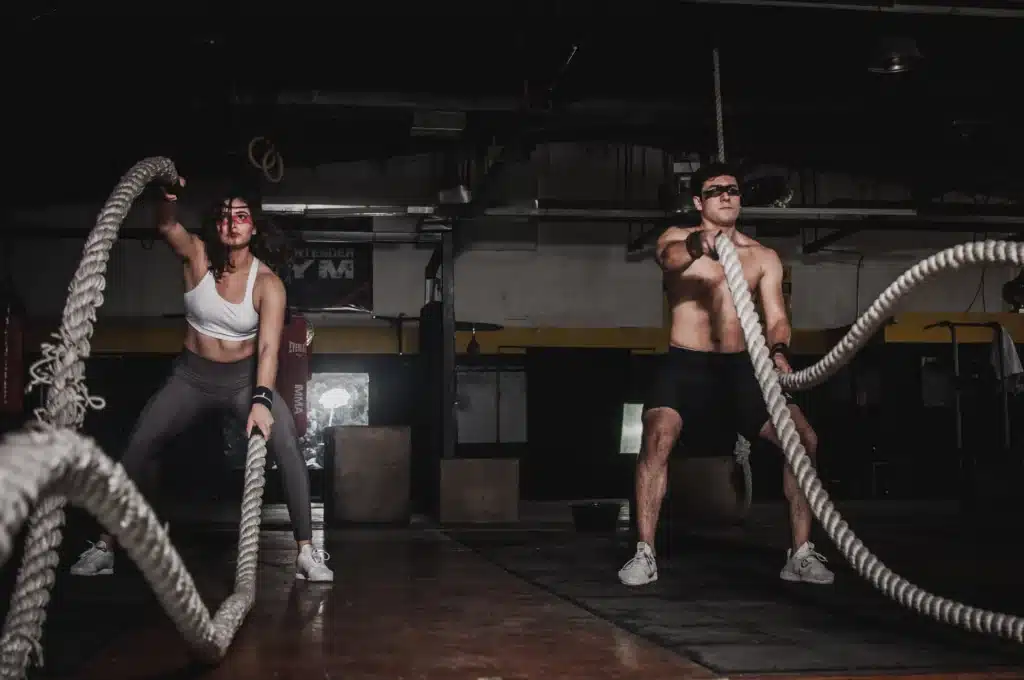
Strength training, also referred to as ‘resistance training’ or ‘weight training’, has been shown through research to lower anxiety and stress levels. Its wide-ranging benefits extend to both physical and mental health, offering relief from symptoms associated with anxiety and panic attacks.
1. Weight Lifting
Weightlifting is a valuable workout exercise for panic attacks and anxiety as it helps in managing them. Research has found weightlifting has great benefits for anxiety, depression, and PTSD. Incorporating it into your daily routine can be of great benefit to your mental health.
How does it help?
- It reduces anxiety sensitivity by desensitizing physical sensations of anxiety like increased heart rate and sweating and making it easier to manage them.
- The physical exertion involved in weight lifting helps release endorphins, which are natural mood boosters and reduces cortisol levels, the stress hormone.
- Weight lifting also diverts attention from anxious thoughts and promotes mindfulness, helping to stay in the present moment, both of which are beneficial for anxiety and panic attacks.
- Pausing between sets to do deep breathing exercises and meditation can enhance the benefits of weight lifting for anxiety and panic attacks.
How much to do?
For individuals experiencing anxiety and panic attacks, the amount of weight lifting to start with depends on their current fitness level, strength, and any physical limitations. Beginners can start with a lightweight, such as 1-2 kilograms, and then increase the weight gradually. Start with simple exercises such as leg presses, shoulder presses, and bicep curls.
Note: Please consult a professional in the relevant field who can guide you properly about strength training. Don’t perform it on your own.
2. BodyWeight Exercises
Bodyweight exercises such as squats, pushups, lunges, planks, and jumping jacks help with anxiety and panic attacks. Let’s read about how they help us.
How does it help?
- As you do bodyweight exercises regularly, you will notice improvements in your strength, flexibility, and endurance that boost your self-confidence and make you more capable of handling challenging situations. Having a sense of control and resilience helps reduce anxiety and panic attacks.
- Practicing bodyweight exercises triggers the release of dopamine and serotonin, which are associated with feelings of happiness and improved mood, which can lead to reduced anxiety and panic attacks.
- It also takes your mind off worries and reduces anxiety.
How much to do?
You should start slowly and then gradually increase the intensity of these exercises.
- Squats: Start with 10-15 squats per session and take breaks in between. Increase the number of repetitions as you feel comfortable.
- Push-ups: Begin with 10-15 push-ups either against the wall, on your knees, or on elevated surfaces.
- Lunges: Practice 5-10 lunges on each leg, focusing on maintaining proper form and balance. Increase the number of repetitions or sets as you progress.
- Jumping Jacks: Start with 10-15 jumping jacks and then slowly add more sets according to your fitness level and comfort.
- Plank: Start by holding a plank position for 20-30 seconds, and then gradually increase the duration as you become stronger.
Remember, everyone’s fitness level and strength to do exercise are different. Consult with a qualified trainer or fitness professional if you have any underlying health conditions.
Mind Body Practices
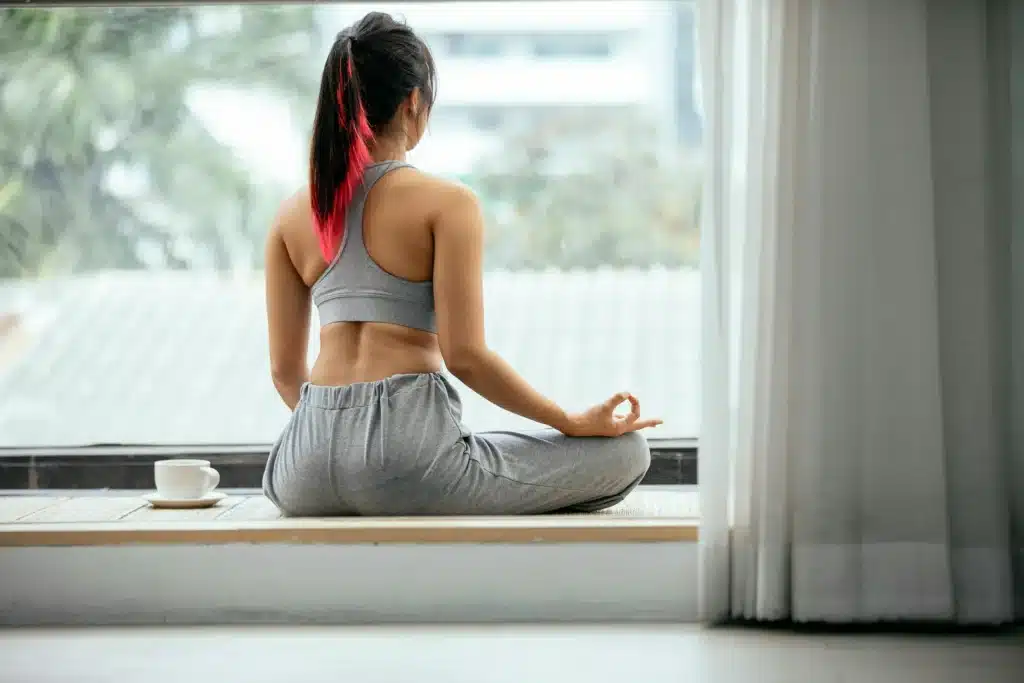
There are many mindfulness exercises for stress and anxiety. As these exercises tune the body and mind together, they help reduce the intensity of panic attacks and anxiety.
1. Mindfulness Meditation
Engaging in mindfulness meditation proves valuable in handling anxiety and panic attacks. Studies highlight its moderate effectiveness in enhancing anxiety through mindfulness-based therapy.
How does it help?
- Mindfulness helps you become aware of your thoughts, feelings, and bodily sensations without getting sucked into them when anxiety and panic attacks arise. It involves accepting everything and paying attention to the present moment with a non-judgmental attitude.
- It can also help individuals develop a sense of inner calm and peace, which can be beneficial in preventing and managing anxiety and panic attacks.
How Should I Practice Mindfulness Meditation?
- Find a quiet and peaceful place where you can sit comfortably. Close your eyes and take a few deep breaths to relax yourself.
- Begin by bringing your attention to the top of your head and noticing any sensations. Slowly move your attention down your body, to your forehead, eyes, nose, mouth, shoulders, arms, hands, chest, stomach, hips, legs, feet, and toes. As you move through each body part, notice any tension, tightness, or discomfort. If you find any tension or uneasiness, try to relax and release it through deep breathing or gentle stretching.
- Now give attention to your breathing. Focus on the rise and fall of your chest as you inhale and exhale.
- After that, notice the entire space around you. Sounds, smells, skin sensations, and other sensory experiences. Observe these sensations without judgment or attachment.
- When you feel anxiety or panic rising, gently bring your attention back to the present moment. Focus on your breath, body sensations, or sensory experiences. Remind yourself that you are safe and that this moment is temporary.
- Try repeating a simple affirmation to yourself if you feel overwhelmed by anxiety and panic attacks, such as ‘I am safe’ or ‘This is going to pass’. Or ‘I can handle this’.
- Imagine a peaceful place, such as a tranquil forest or calm beach.
- Be non-judgmental during meditation. It is okay to have difficult emotions and they will eventually pass. Observe your thoughts and feelings without judging and controlling them.
- Open your eyes and come back to the present moment. Take a few deep breaths and stretch your body. Reflect on how you are feeling and notice any shifts in your anxiety levels.
2. Body Scan
Being aware of what is happening in your body during anxiety and panic attacks can help you cope with them faster and more easily. Doing a whole-body scan can help you compose your thoughts and be mindful of your body. Research studies show that doing body scans regularly can help reduce stress and manage anxiety.
How should I practice Body scanning?
- Sit or lie down comfortably in a quiet room, close your eyes, and take a few deep breaths to relax.
- Start paying attention to your toes, then move to your legs, thighs, belly, chest, back, arms, neck, and face. Slowly move your focus to each part, spending a few moments on each.
- Focus on each part of your body. Imagine it in your mind, and then find out how it feels. Does it feel hot, cold, tight, relaxed, or tingly? or the complete lack of feeling.
- If you notice tension, breathe into that area and consciously relax it as best as you can.
- Don’t judge your thoughts and sensations; just observe them.
- As you scan, be aware of any emotions or thoughts that arise without getting caught up in them. Acknowledge and let them pass.
- Repeat this as you move through each part of your body until you get to your face and head.
- Aim for a few minutes daily. It’s okay if your mind wanders; gently guide your attention back to the body part you’re scanning.
3. Mindful Walk
Mindful walking is also known as ‘Walking meditation.’ It offers great benefits for physical and mental well being.
Benefits of Mindful Walk
- A mindful walk enhances awareness of the present moment, giving you a sense of calm and focus.
- Research shows that exercising outdoors and in nature, especially in a mindful way, is better for your mental health. It indicates that a mindful walk in nature will be of great benefit.
- The rhythmic movement during mindful walking reduces stress and anxiety levels, improving mood and emotional well being and helping you to concentrate on the present.
How to do Mindful Walk?
- During walking meditation, focus on the steps you are taking.
- Take small steps and while putting one foot before another, you observe how it feels—the rhythm and sensations of your feet walking on the ground.
- While walking, you can also observe the sights, smells, and sounds around you as you walk.
4. Yoga
According to research, yoga improves health and helps manage stress. There are many yoga exercises for stress and anxiety that can be helpful to overcome them.
Benefits of Yoga
- Deep breathing techniques in yoga, such as pranayama, help to calm the nervous system and reduce anxiety.
- Yoga brings awareness to the present moment and lets go of distractions, helping to manage anxiety and panic attacks.
- Yoga enhances body awareness, allowing individuals to recognize tension and stress in their bodies and respond with relaxation techniques.
- Yoga poses involve stretches, which release tension from muscles and promote relaxation, helping to relieve physical symptoms of anxiety.
How to do Yoga?
- Choose gentle and simple yoga poses such as seated forward folds, cat and cow poses, and child’s poses.
- Coordinate your movements with your breath. Inhale during stretches and exhale during contractions.
- Hold every pose for 5 to 10 breaths.
- Include mindful meditation or breathing during yoga to enhance the calming effects.
- Pay attention to sensations in your body during poses and consciously release tension.
Remember to consult with a healthcare professional or a qualified yoga instructor before starting a yoga practice, especially if you have specific health conditions.
5. Tai Chi
Tai Chi is a Chinese wellness practice and an effective exercise for anxiety and panic attacks.
A research study shows that Tai Chi helps reduce depression, anxiety and improve mental well being.
Benefits of Tai Chi
- Tai Chi helps focus on the present moment, reducing stress and anxiety.
- Tai Chi helps to improve balance and coordination, which can make you feel more confident and in control of your body. This can be helpful for people who experience anxiety or panic attacks, which can often cause feelings of dizziness or lightheadedness.
- Anxiety and panic attacks can often lead to insomnia and Tai Chi helps with it by improving your sleep quality.
How to do Tai Chi?
- Find a qualified Tai Chi instructor.
- Start with a beginner class.
- Wear comfortable clothing that allows you to move easily.
- Find a quiet place to practice where you will not be disturbed.
- Stand with your feet shoulder-width apart and slightly bend your knees.
- Relax your shoulders and let your arms hang naturally at your sides.
- Take a deep breath and exhale slowly.
- Begin moving your body slowly and fluidly, following the instructions of your instructor.
- Focus on your breath and movement.
- Enjoy the process.
6. Pilates
Doing pilates regularly helps counteract anxiety and panic attacks. Pilates helps improve symptoms of depression, anxiety, and fatigue, according to the research.
Benefits of Pilates
- Pilates helps to take your mind off stressful events that can result in anxiety and panic attacks.
- Pilates can boost endorphins, which improves your mood.
- Pilates exercises focus heavily on your breaths, so it improves your overall energy and helps you with anxiety and panic attacks.
How to do?
Diaphragmatic Breathing
- Lie down on your back with your feet flat on the ground and your knees bent.
- Place your hand on your stomach and inhale deeply through your nose, feeling your stomach rise.
- Exhale slowly through your mouth, contracting your abdomen.
- Continue this deep breathing exercise for 5-10 minutes.
Standing Forward Bend
- Stand with your feet hip-width apart and bend forward from your hips, keeping your back straight.
- Let your arms hang down loosely.
- Take a few deep breaths, and relax your neck and shoulders.
- Hold the pose for 5-10 minutes.
Double Leg Stretch
- Lie on your back with your legs extended and your arms by your sides.
- Bend your knees and bring your thighs close to your chest.
- Gently pull your knees closer to your chest until you feel a stretch in your lower back.
- Hold the pose for 5-10 minutes.
Cat Cow Pose
- Start on your hands and knees with your hands shoulder-width apart and your knees hip-width apart.
- Inhale and arch your back, lifting your head and tailbone.
- Exhale and round your back, tucking your chin to your chest.
- Repeat the sequence for 5-10 minutes.
Breathing Exercises and Relaxation Techniques for Anxiety
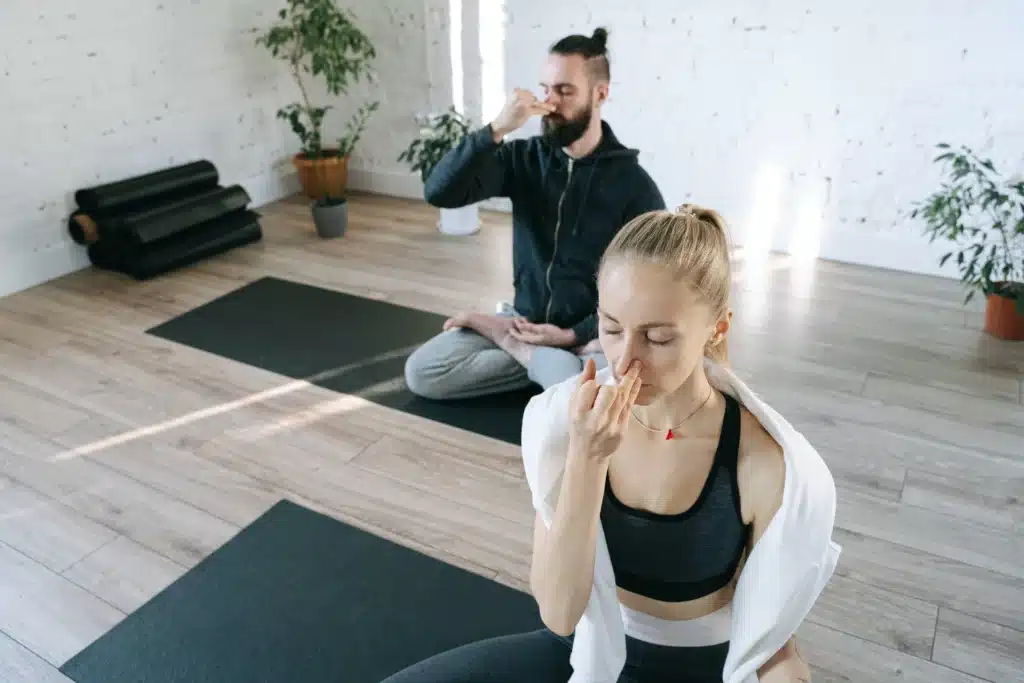
Having anxiety can be overwhelming but there are breathing exercises to relieve stress and anxiety. Let’s study them so that when you find yourself again in the loop of anxiety, you can practice these exercises.
1. Visualization
You may have heard about visualization. If not, then let me tell you that it has a great impact on our mental and emotional state. Visualization makes you think of something positive and calming and it has a peaceful effect on how you feel about managing your anxiety.
Research shows that nature-based guided imagery, known as visualization, helps decrease anxiety.
How to visualize?
Imagine a calming place of nature such as the mountains, forest, or beach. Focus on that place and feel it with all your senses. See yourself in that place and notice your surroundings. What do you see, hear, and smell? Doing this is known as Visualization.
2. Diaphragmatic Breathing or Belly Breathing
Diaphragmatic breathing or belly breathing has many benefits for anxiety, as research studies show that diaphragmatic breathing triggers body relaxation and reduces stress.
How to do Diaphragmatic Breathing?
- Put a hand on your chest and another hand below your ribcage on your abdomen.
- Inhale deeply through your nose and sense the air moving down to your abdomen.
- Then exhale slowly for a few seconds while pursing your lips.
- During the whole process, focus on how your stomach contracts and expands while your chest makes only a few slight movements.
3. Five-Count Breath
Out of many breathing exercises for anxiety and panic attacks, five-count breathing is one of them. It can also help you manage your anxiety.
How to do Five Count Breath?
- Inhale your breath for the count of 5.
- Hold your breath for the count of 5.
- Exhale your breath for the count of 5.
Repeat this until you feel relaxed. You can imagine it as a triangle, with each step taking a side.
4. Lion’s Breath
Lion’s breath is yogic breathing that alleviates stress and soothes you.
How to do Lion’s Breath?
- Sit cross-legged on a cushion or a soft surface, with your back straight. Ensure your knees are wider than your shoulders and your feet are flat on the floor.
- Gently close your eyes to focus inward and eliminate distractions.
- Inhale slowly and deeply through your nose, expanding your abdomen. Allow your stomach to rise as you fill your lungs with air.
- As you exhale, open your mouth wide and stick out your tongue.
Simultaneously, make a deep, guttural roar as if you were a lion. The sound should come from the back of your throat.
- Inhale through your nose and exhale with the lion’s roar. Continue this cycle for a few minutes, or as long as you feel comfortable.
- When you’re ready, close your mouth and gently bring your tongue back in.
- After the lion’s breathing exercise, you should feel calmer and more relaxed.
5. Square Breathing
Square breathing is also known as Box breathing. When anxiety strikes, your body tunes into a stress response, showing symptoms such as an increased heart rate or rapid breathing. So anxiety changes your breathing pattern when your body is experiencing it; therefore, you can practice square breathing, as it could effectively keep you in relaxation mode and help regulate anxiety.
How to do Square Breathing?
- Breathe in for four counts.
- 4 counts of holding your breath
- Count to four while you exhale.
- For four counts, hold your breath.
Continue this for 4-5 times or as much as you like, until you feel calmer.
6. Alternate Nostril Breathing
Alternate nostril breathing can be a good option for treating anxiety and calming you.
How do you do alternate nostril breathing?
Begin by breathing in and taking your right hand up to your face. Gently press on your right nostril with your right thumb and then exhale from the left nostril. After exhaling, use your ring finger to press your left nostril. Inhale fully with your right nostril. Repeat this again by switching your nostrils.
7. Progressive Muscle Relaxation (PMR)
Muscle tension is a part of anxiety and progressive muscle tension can be helpful to alleviate the muscle tension that comes with anxiety.
How do I do PMR?
Start by curling your toes; hold this position for about 10 seconds and then release. Continue tensing all the muscles in your body and don’t go to the point of straining. Continue tensing your calves, arms, stomach, upper legs, shoulders, hands, and face. Finish the exercise by tensing your whole body for 5 seconds and then releasing.
Breathing Exercises and Relaxation Techniques for Panic Attacks
While breathing exercises for panic attacks include Alternate nostril breathing, Square breathing and Lion’s breathing, there are also other breathing exercises for panic attacks. Let’s discuss them.
1. 4-7-8 Breathing Technique
It is the yogic pranayama breathing exercise. This exercise reduces anxiety, improves your sleep pattern, and helps with panic attacks.
How to do 4-7-8 breathing?
- Find a comfortable position.
- Inhale slowly and deeply through your nose, counting to four mentally.
- Hold your breath for seven counts.
- Exhale slowly and completely through your mouth, counting to eight.
- Repeat this cycle for several minutes, focusing on the rhythm of your breath.
2. Pursed Lip Breathing
Pursed lip breathing reduces stress while slowing your breathing. Panic attack symptoms result in shortness of breath, so this type of breathing manages it.
How to do Pursed lip breathing?
- Inhale slowly through your nose for a count of two.
- Then, pucker your lips as if you are about to blow a whistle or a candle, and exhale slowly through your pursed lips for a count of four.
This technique helps regulate your breathing and releases tension.
Breathing exercises can be effective only when you practice them regularly. Over time, these exercises will become a valuable tool for managing your anxiety and panic attacks.
Precautions and Safety Considerations
There are many precautions and safety considerations you should take to avoid any injuries.
- Consider seeking professional guidance from a therapist or stress management specialist for personalized strategies and support.
- Know your current fitness level and any injuries or limitations to prevent overexertion and injuries.
- Listen to your body throughout your exercise journey. Paying attention to fatigue, pain, discomfort, and other bodily signals allows you to modify exercises, take rest days, and prevent pushing yourself too far.
- Seeking professional help is crucial if symptoms persist despite adjustments and adequate rest. If you experience pain, dizziness, difficulty breathing, or other concerning symptoms, consulting a healthcare professional for proper diagnosis and guidance is important.
Additional Tips for Managing Anxiety Through Exercise
There are many other tips and tricks that you can add to your exercise routine to make it more effective.
1. Setting Realistic Goals
First, you have to find out different exercises for anxiety and panic attacks and start small and specific. Slowly increase the intensity and pace of exercise. Focus on progress by celebrating small wins. Make your goals measurable to track progress.
2. Choosing Suitable Exercises Based on Fitness Level
Exercises for anxiety and panic attacks are so many that you can choose according to your preferences. Identify your fitness level and start with simple exercise. Consult a doctor or fitness professional if you have any concerns.
3. Incorporating Exercise into Daily Life
Schedule workouts on your calendar and treat them like important appointments. Find exercises that you enjoy; this will make you stick with them. Use technology to track your progress and stay accountable. There are many apps and fitness trackers available to help you stay on track.
4. Consistency and Regularity
Be consistent and regular in terms of exercising; this is only going to happen when you start small and don’t go for the big jump in the beginning. Don’t expect too much from yourself in the beginning. Start from 5 minutes to 10 minutes but be consistent because only consistency and regularity will make you see the difference in terms of anxiety disorder and exercise.
5. Finding Enjoyment in Physical Activities
This is the most crucial part. You should opt for exercise that makes you feel enjoyable and happier. Do you love cycling? Then do it. Love water and swimming? Then choose that. Don’t force yourself into those exercises that feel like a burden and don’t make you happier.
Combining Exercise with Other Stress-Relief Techniques
We have read much about how does exercise help with stress and anxiety. Now we are going to study other stress relief techniques that, when combined with exercise, provide a great effect.
1. Hydration Hero
Keeping yourself hydrated throughout the day, especially before, during, and after exercise, improves your mood and makes you resilient to stress.
2. Fuel your Mood
Foods rich in vitamins, minerals, and complex carbohydrates are nutritious, and they provide sustained energy and support emotional well-being.
3. Nature’s Therapy
Try to spend some time in nature like walking in the park, hiking in the forest, or simply sitting beside a calming stream. Nature has a great ability to reduce stress, boost your mood, and calm your mind.
4. Music Therapy
There is a lot of calming music available online. Listen to what you like. Create playlists with calming music, nature sounds, or binaural beats to induce relaxation and reduce anxiety.
5. Aromatherapy Aura
You can use essential oils like lavender, chamomile, or bergamot in diffusers or baths to create a calming ambiance. You can also use scented candles with lavender, chamomile, and jasmine flavors to calm and relax your mind.
6. 54321 Method
It is a grounding technique that helps you divert your attention when you are feeling anxious. This involves using all your senses to center yourself in the present moment and make peace with your anxiety. Here is how you do it:
- Look for 5 things you can see around you.
- Focus on 4 things you can touch
- Listen for 3 things you can hear
- Find 2 things you can smell
- Name 1 thing you can taste
7. Creative Calming
Engage in activities like journaling, coloring, or playing music to express yourself and reduce mental strain.
By combining exercise with these complementary stress-relief techniques, you can build a holistic approach to managing stress, boost your mood, and create a more resilient and well-being-focused lifestyle.
Conclusion
Physical, mental, and breathing exercises are all included in the broad category of exercises for anxiety and panic attacks. With so many variations available for each of these, you can select the one that most comfortably suits you.
Anyone who has the question in their mind: Does exercise help panic attacks and anxiety? must be answered after reading this article. But it is also important to take guidance from healthcare professionals regarding exercises, as they can better teach you about anxiety and panic attacks, especially if you have a specific health concern.
Having anxiety and panic attacks is not a bad thing and is not in your control but your reaction is in your control. How do you tackle it? What do you do to overcome anxiety and panic attacks? This is all that matters. So start today and take steps to overcome anxiety disorder and exercise is the best way to fight that.
Frequently Asked Questions
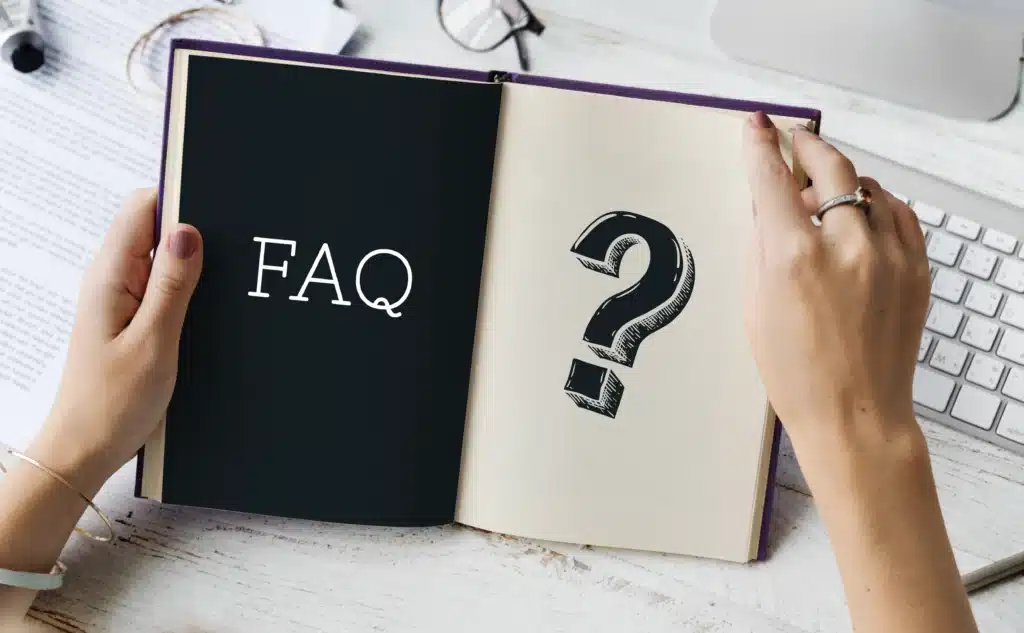
How do you stop a panic attack fast?
Try to control your breathing by taking slow, deep breaths. Focus on inhaling deeply through your nose and exhaling slowly through your mouth. Try to relax your body by tensing and then releasing different muscle groups. Engage your senses by focusing on objects in your surroundings, such as colors, shapes, and textures. If possible, step outside or move to a different room to change your environment.
How to calm down anxiety?
You can calm down anxiety by deep breathing, relaxing your muscles, visualizing, focusing on the present moment, and doing different exercises.
What foods are good for anxiety?
Foods rich in omega-3 fatty acids, such as salmon, tuna, mackerel, and walnuts, have been shown to reduce anxiety symptoms. Omega-3 fatty acids are essential for brain health and function, and they may help to regulate the production of serotonin, a neurotransmitter that is involved in mood regulation.
Additionally, foods high in magnesium, such as dark leafy greens, nuts, and seeds, may also help to reduce anxiety.
Which vitamin helps with anxiety?
Vitamin D, B complex, magnesium, and vitamin C are some vitamins that have been studied for their potential role in managing anxiety. More research is needed, but some evidence suggests that these vitamins may be beneficial. However, taking vitamin supplements should not be used as a substitute for professional medical treatment for anxiety disorders. If you are experiencing anxiety symptoms, consult with a healthcare professional to determine the best course of treatment.
What is the best medicine for panic attacks?
Fluoxetine (Prozac), paroxetine (Paxil, Pexeva) and sertraline (Zoloft) are the best medicines for panic attacks, as approved by the FDA. If you are experiencing panic attacks, it is important to see a doctor to determine the best course of treatment. A doctor can assess your symptoms and recommend the appropriate medication or combination of medications. They can also help you develop a treatment plan that includes therapy and lifestyle changes.
Can diet and exercise help anxiety?
Yes, diet and exercise both play a major role in managing anxiety symptoms. Exercise helps reduce stress hormones, improves sleep, and increases serotonin levels. A healthy diet rich in fruits, vegetables, and whole grains also supports serotonin production. Caffeine and sugar can worsen anxiety symptoms, so limiting their intake is recommended. To make dietary changes for anxiety, increase intake of whole foods, choose lean protein sources, and limit processed foods, sugary drinks, and unhealthy fats. For effective exercise, find an enjoyable activity, start slowly, aim for 30 minutes of moderate-intensity exercise most days of the week, and consider having a workout buddy or joining a group class.
Can exercise help relieve depression and anxiety disorders?
Yes, research has shown that exercise can be an effective treatment for depression and anxiety. A 2018 review of studies published in the journal JAMA Psychiatry found that exercise was as effective as medication for treating depression, and it was more effective than medication for treating anxiety.
Is exercise good for depression and anxiety?
Yes, exercise has been shown to have positive effects on depression and anxiety by releasing endorphins, which are mood boosters and reduce stress. It also improves your sleep, boosts your self-esteem and improves your cognitive function so it indirectly helps with depression and anxiety.
